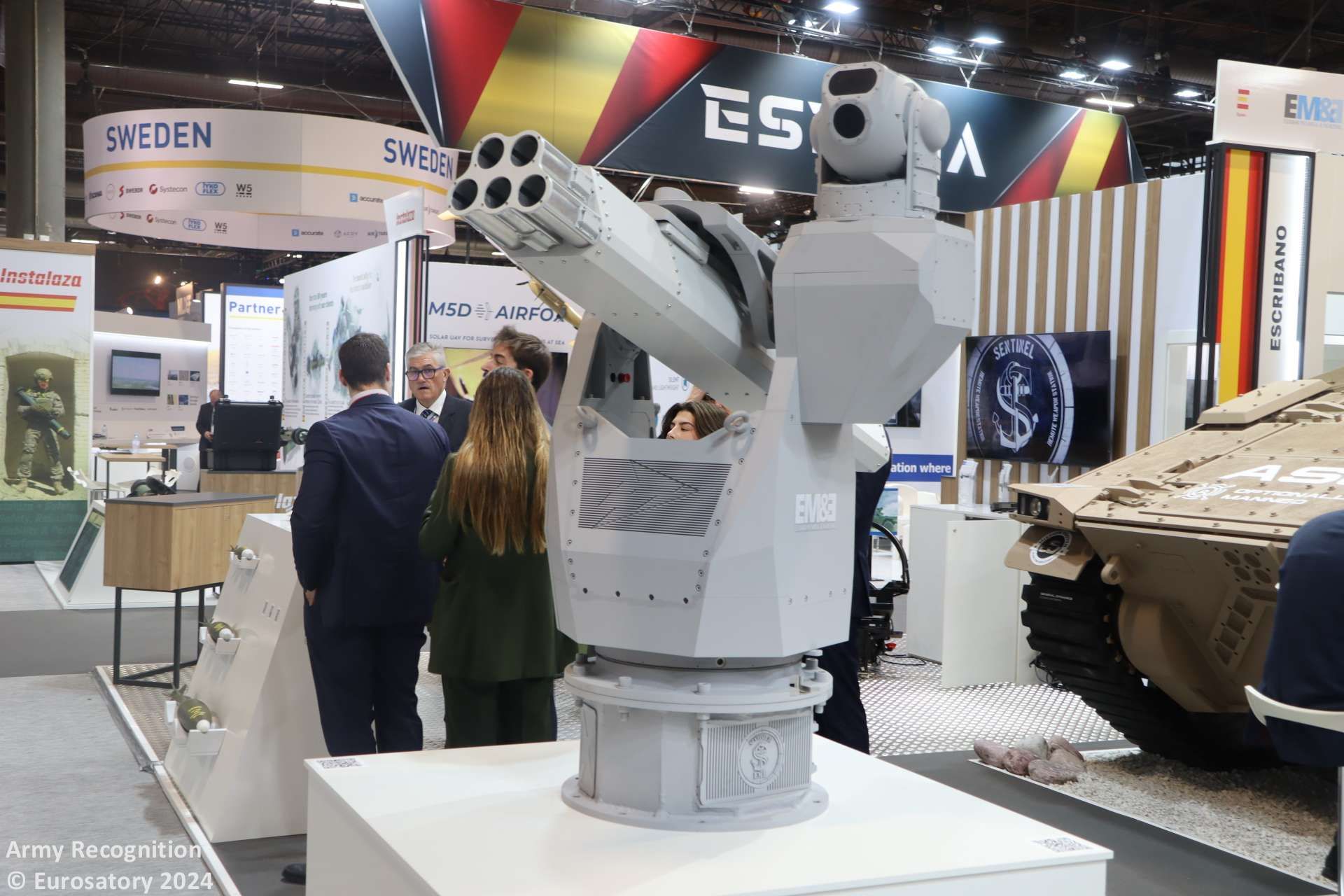Breaking News
Escribano and Thales collaborate on Sentinel Rocket weapon system to counter drone threats.
On June 18, 2024, the Spanish company Escribano Mechanical & Engineering and the French company Thales entered into an international agreement to collaborate on the Sentinel Rocket remotely controlled rocket weapon system and offer a joint solution for neutralizing threats in the naval and land-based Counter-Unmanned Aircraft System (C-UAS) field. This agreement was formalized at the Eurosatory 2024 defense exhibition, aimed at addressing the emerging threats posed by drones and drone swarms through advanced technology and joint expertise.
Follow Army Recognition on Google News at this link

Escribano Mechanical & Engineering and Thales will collaborate on the Sentinel Rocket remotely controlled rocket weapon system to offer a joint solution for neutralizing threats in the naval and land-based Counter-Unmanned Aircraft System (C-UAS) field. (Picture source: Escribano)
The collaboration combines the strengths of both companies, integrating Escribano's remotely operated weapon stations with Thales' launchers and missiles. The result of this partnership is the Sentinel Rocket, a system designed to enhance the capabilities of naval and terrestrial defense forces against UAV threats. The Sentinel Rocket system integrates Escribano's gyrostabilized remote stations, equipped with an electro-optical system, and Thales' rocket launchers, which have high propulsion speed, a range of up to 3 kilometers, and can deploy over 8,000 steel balls, creating a steel cloud.
Jocxan Bojorquez, Business Development Director at Escribano, emphasized the need for innovation in addressing new security threats, noting that the combined technological and industrial capabilities of both companies have produced a technologically advanced product. Thomas Colinet, Rocket System Domain Director at Thales Belgium, expressed his satisfaction with the partnership, highlighting its alignment with European efforts to strengthen the industrial base and technological sovereignty.
The agreement between Escribano and Thales supports the European Union's Defense and Security Policy, which aims to enhance the European defense industrial base. In an environment with increasing threats, the collaboration seeks to optimize investments and capabilities through cooperation among European defense companies, thereby strengthening the region's collective security posture.
Escribano, established in 1989, has evolved from a small mechanical workshop in Spain into a global company in the defense and security sector. The company provides comprehensive engineering solutions, high-precision mechanical manufacturing, and the production of complex optronic integration systems. Escribano's product range includes stabilized platforms for land, naval, and airborne applications, thermal cameras and sensors for border surveillance, and ammunition guidance kits. The company conducts all product development and customer-specific adaptations in-house at its Madrid facilities, focusing on innovation and the integration of artificial intelligence into its solutions.
Thales, listed on Euronext Paris under the ticker HO, specializes in three primary business areas: Defense & Security, Aeronautics & Space, and Cybersecurity & Digital Identity. The company employs around 81,000 people across 68 countries and generated sales of €18.4 billion in 2023. Thales invests nearly €4 billion annually in research and development, focusing on areas such as artificial intelligence, cybersecurity, quantum technologies, cloud technologies, and 6G.

The launcher is compatible with both guided (LGR) and unguided (UGR) rocket munitions, specifically the guided FZ275 LGR and unguided UGR 2.75" rockets. (Picture source: Army Recognition)
The Sentinel Rocket system is a remotely controlled rocket weapon station designed for enhanced stabilization and day/night targeting capabilities. This gyro-stabilized platform is capable of operating rocket launchers for combat and surveillance missions under various conditions. The Sentinel Rocket system features a 2-axis gyro-stabilized platform with an elevation range of -20 to +60 degrees and an azimuth rotation of 359 degrees, maintaining a stabilization level of less than 1 milliradian.
The FZ605 rocket launcher, part of the Sentinel Rocket system, is designed to minimize payload and exposure to rocket exhaust gases. It can be integrated on airborne platforms with NATO 14" lugs and on land vehicles with flat interfaces. The launcher is compatible with both guided (LGR) and unguided (UGR) rocket munitions, specifically the guided FZ275 LGR and unguided UGR 2.75" rockets. These rockets feature a semi-active laser guidance system for precision targeting and can be equipped with high explosive warheads. The guided FZ275 LGR incorporates a SUKL dual-mode semi-active laser seeker that receives coded laser designator pulses for supplemental guidance after launch. Both guided and unguided variants can be configured with high explosive warheads, offering flexibility and precision in various combat scenarios.
The Sentinel Rocket's electro-optical suite includes a cooled 3rd generation mid-wave infrared camera with a 640x512 resolution and a 20x continuous zoom. This IR camera offers a wide field-of-view (WFOV) of 26.30° horizontal and 20.98° vertical, and a narrow field-of-view (NFOV) of 1.31° horizontal and 1.05° vertical. Additionally, the system includes a laser rangefinder accurate to ±5 meters up to 8,000 meters with a programmable pulse rate of 1-10Hz, and a high-definition day sight camera with a CMOS sensor offering a 1920x1080 resolution and a 30x continuous zoom. The day sight camera also provides a WFOV of 55.9° horizontal and 35.6° vertical, and a NFOV of 2.1° horizontal and 1.2° vertical.
Under typical conditions, the sensors integrated into the Sentinel Rocket system can detect a NATO target measuring 2.3 x 2.3 meters at a distance of 19.17 kilometers in visible wavelengths and 16.01 kilometers in infrared wavelengths. The system's recognition and identification ranges are 6.5 kilometers and 4.41 kilometers, respectively, providing robust situational awareness and targeting capabilities.


























